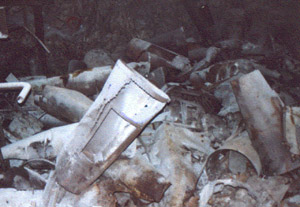
The entrance
KZ-Gedenkstätte "Mittelbau-Dora"
Concentration Camp Memorial "Mittelbau-Dora"

The entrance
This page is respectfully dedicated to all those
who suffered persecution at the hands of those who foolishly thought themselves
The Master Race
Konzentrationslager "Mittelbau-Dora"
After the massive bombardment of the Peenemünde test sites on
August 17/18 1943 the decision was taken by Speer and the Wehrmacht to
move the production of the V2 rocket underground. The tunnels selected,
near the town of Nordhausen at the southern edge of the Harz, were under
the Kohnstein mountain. They existed as a strategic fuel and chemical weapon
store. Himmler wished to become involved in the project so provided unlimited
manpower from the Concentration Camp system.
The tunnels are 20 km (12.5 miles) in length and up to 30 m (33 ft)
high
KZ Dora was founded as a sub camp of KZ Buchenwald and from September
1943 the first prisoners arrived to enlarge the tunnel system. They were
housed in the tunnels and seldom saw the light of day.
"Mittelwerke-GmbH" was established in November 1943 to mass-produce
the V2 rocket. In In January 1944 the first 52 rockets were delivered
at the cost of 679 prisoner's deaths.
The construction of a crematorium was begun in February 1944 (and completed
March) to dispose of prisoner's bodies. Previously they had been transported
to KZ Bergen-Belsen.
In May 1944 the wooden huts were constructed to house the growing prisoner
population.
Production of the V1 pulse jet flying bomb was started in August 1944
and other production lines, aircraft engines, were set up in the tunnels.
At one time the prison population was 60000.
From January 1945 onward the population grew due to the evacuation
of the camps in the east, ahead of the Soviet advance.
Many thousands died from industrial accidents hunger, exhaustion, beatings.
Public executions were commonplace.
It is estimated that 20000 prisoners died.
The camp was liberated by the US army in April 11th 1945. About 100
complete rockets, many tons of documents and key German technical staff
were shipped to the USA. Twelve rockets were sent to Britain and a few
to France.
The site was then handed over to the Soviet Army.
The camp became a transit camp for displaced persons (DP's).
The Soviet Army removed any components and machinery. The entrances
were blown up and sealed.
At the memorial visitors will see a permanent exhibition in a reconstructed
hut.
Wide range of publications and video tapes available in English.
Films in English, French and German about the history of the camp and
the underground plant can be seen in the memorial's media room in the office
building.
Visitors may use the library and the visitor's archive.
Memorial Opening Times
October until the end of March - Daily 10 am - 4 pm
April until the end of September - Daily 10 am - 6 pm
Guided tours of the Camp and part of the tunnel system
All tours start outside the Museum
Tuesday to Friday - 11 am and 2pm
Saturday and Sunday - 11 am, 1pm, 3pm (and 4pm from April until the
end of September)
Groups can get a tour at any time within opening times when prior arrangement
is made by phone. Tours for groups are offered in English and German.
Single visitors who want a tour in a language other than German call
in good time please.

Visit to the tunnel system

Rocket parts in the tunnels
See "After The Battle Magazine" number 101 for detailed account.

Commemorative badges from Buchenwald, Sachsenhausen, Mittelbau-Dora
and Ravensbrück Concentration Camps

Photograph from a personal c1946 photograph album.
The sign reads:
"This is the site of
The Infamous Belsen Concentration Camp
Liberated by the British on 15 April 1945
10000 unburied dead were found here
Another 13000 have since died
All of them victims of the German New Order in Europe
and an example of Nazi Kultr"
See "After The Battle Magazine" number 89 for detailed account of the
liberation.
First they came for the Jews
and I did not speak out-
because I was not a JewThen they came for the Communists
and I did not speak out-
because I was not a CommunistThen they came for the Trade Unionists
and I did not speak out-
because I was not a Trade UnionistThen they came for Me
and there was no one left
to speak out for Me
Page still under construction
All colour pix © Roy Smith